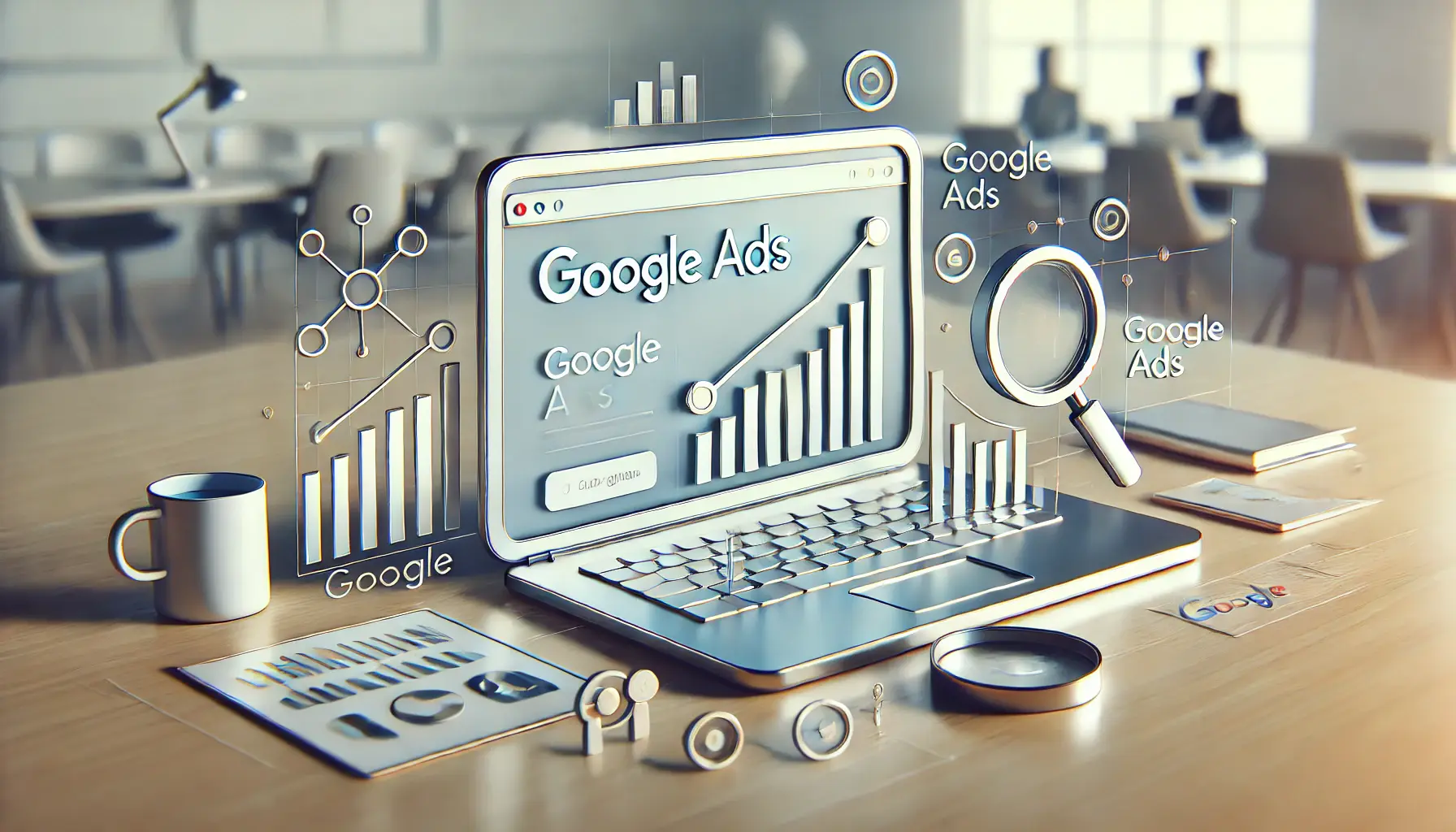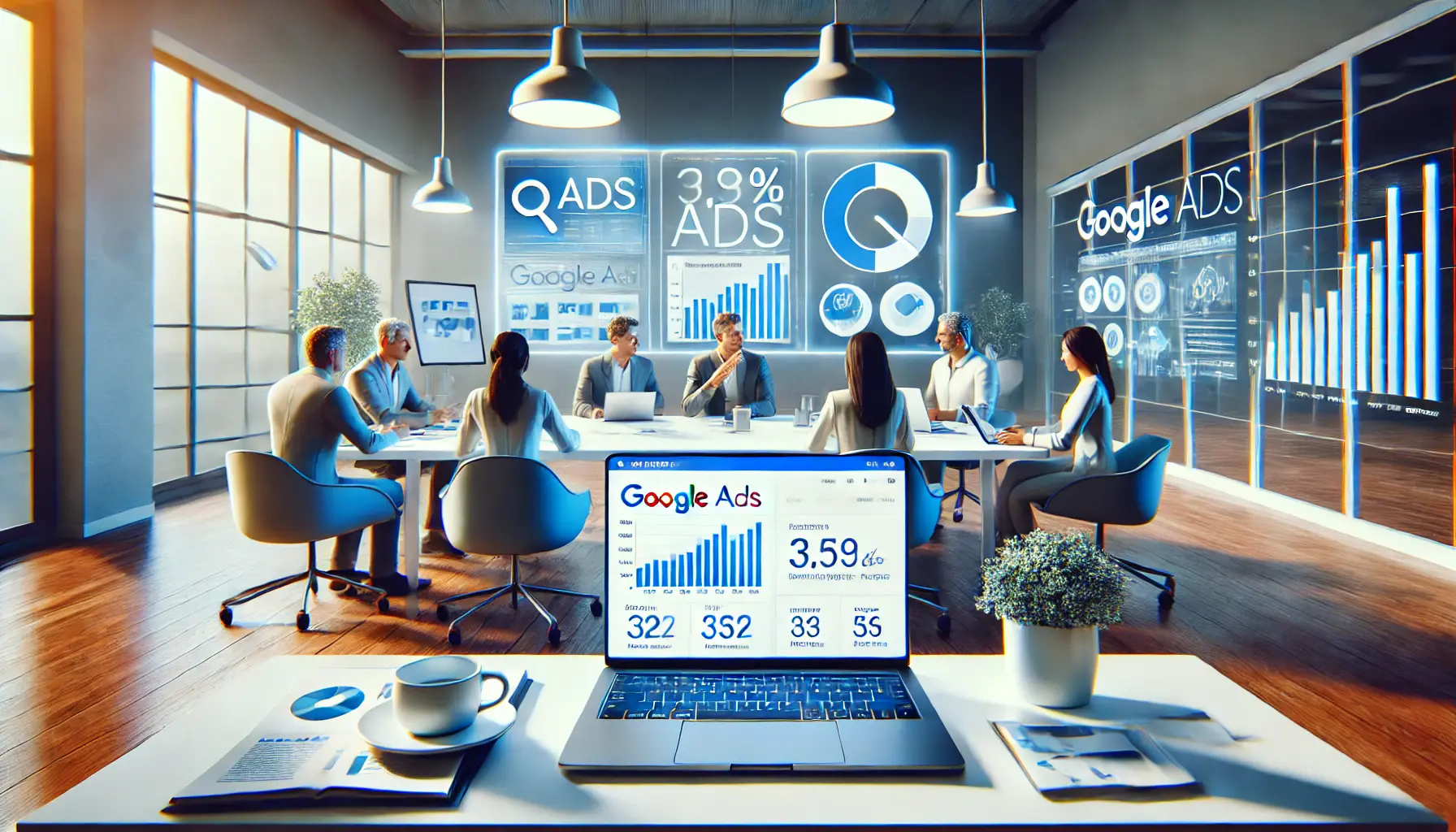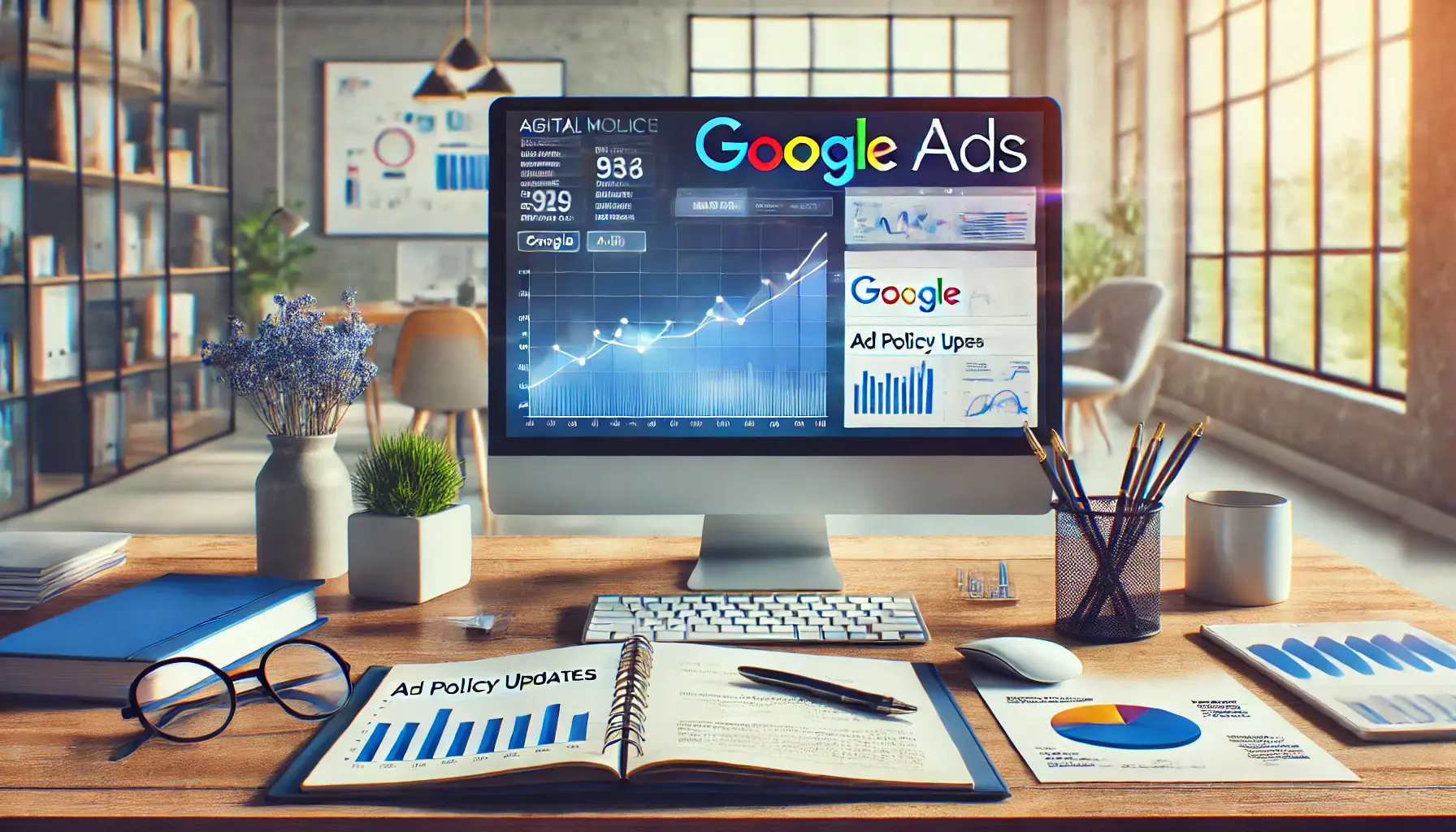Running a Google Ads campaign successfully means understanding ad impressions in order to enhance your campaign’s reach and overall performance.
An ad impressionThe number of times an ad is displayed to users. refers to the number of views your ad gets to users, which directly influences visibility in this competitive advertising landscape.
How to maximize ad impressions without running afoul of the strict policies set by Google, which may even lead to sudden account suspensions, is the challenge.
In this article, we are going to find out how to set up an effective ad impressions strategy within the bounds of Google Ads policies so that your ads will not only reach more users but also be in line with the rules that govern the platform.
- Understanding Ad Impressions in Google Ads
- Optimizing Ad Impressions for Maximum Reach
- Ad Impressions and Compliance with Google Ads Policy
- Analyzing Ad Impressions: Metrics and Tools
- Future Trends: The Emerging Role of Ad Impressions
- Maximizing Ad Impressions for Success with Google Ads
- Common Questions About Ad Impressions in Google Ads
Understanding Ad Impressions in Google Ads
First, let’s talk about what ad impressions really mean when talking about Google Ads.
Ad impressions are views of your ad appearing within a user’s screen.
It doesn’t necessarily mean the user interacted with it, but the appearance of your ad created an opportunity for the user to view it.
Google counts ad impressions in various ways depending on the ad format.
For example, for Search campaigns, one impression is recorded when your ad appears on the search results page.
In Display campaigns, it is counted once your ad shows up on a partner site or app within Google’s Display Network.
This is one of the most basic metrics used in Google Ads, and simultaneously, it is one of the most important metrics.
Clearly, more impressions mean more chances for your ad to result in clicks, conversions, and brand recognition.
However, impressions alone are not enough to ensure success; they are merely the first step a user goes through in your sales funnel.
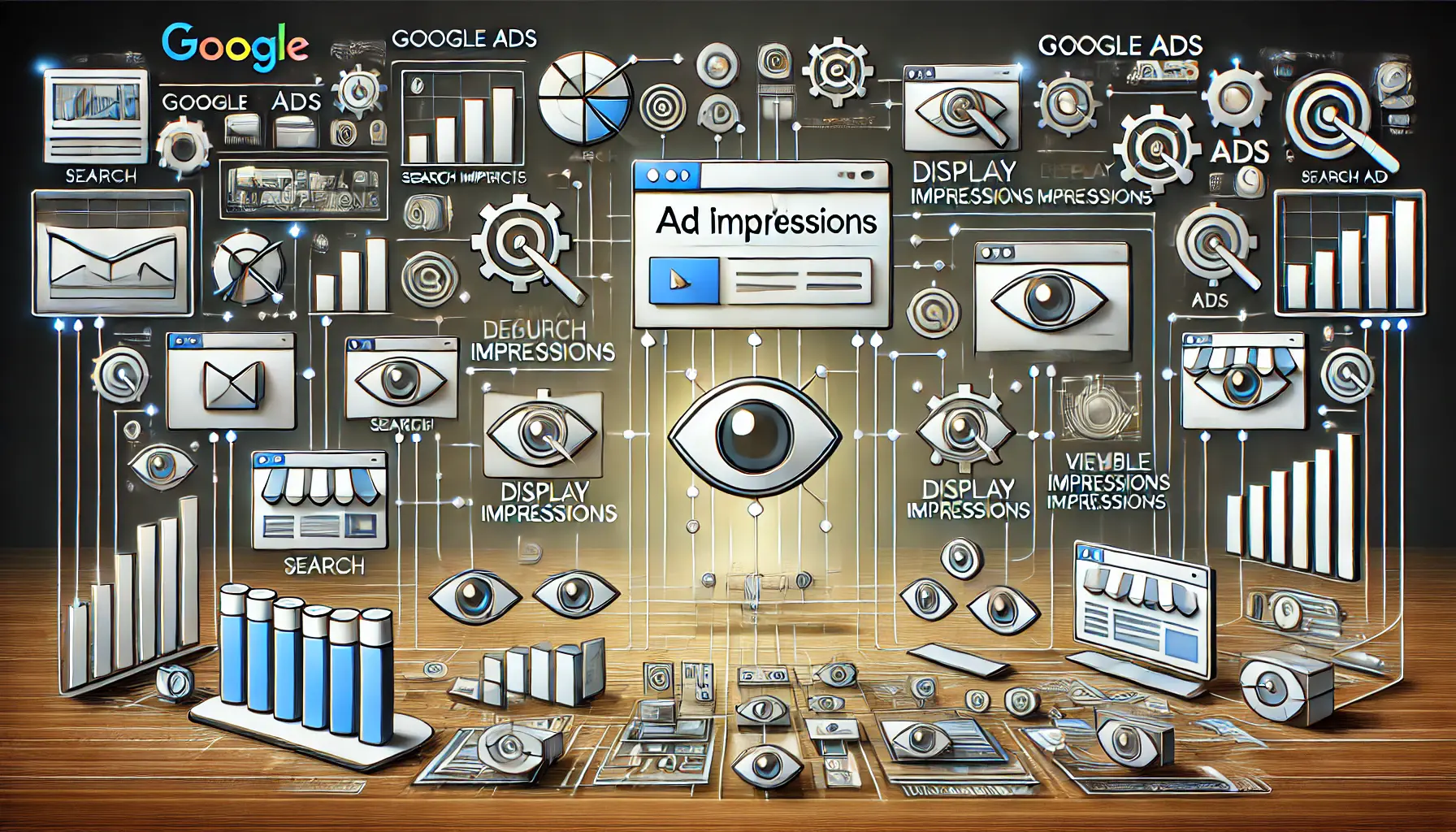
Illustration depicting various types of ad impressions in the Google Ads ecosystem.
Types of Ad Impressions
Google Ads recognizes different types of ad impressions, depending on the campaign type:
- Viewable Impressions: These impressions are counted whenever at least 50% of the ad is in view on the screen for at least one second.
- Non-Viewable Impressions: Instances where an ad has appeared but did not meet the visibility criteria for a viewable impression.
- Search Impressions: Impressions counted when your ad shows up in Google’s search results for search campaigns.
- Display Impressions: These are instances when your ad has appeared on a website or app within Google’s Display Network.
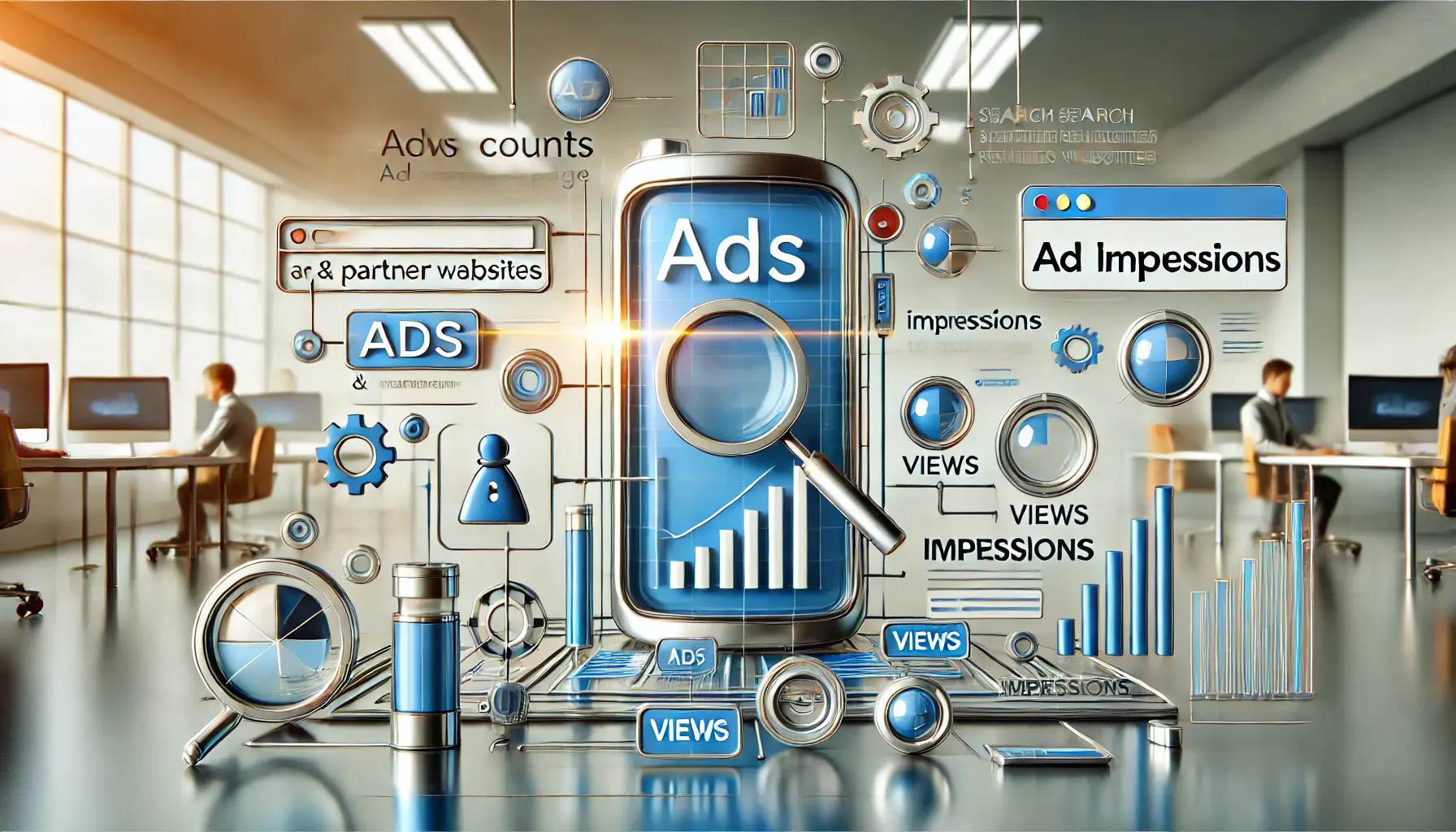
A representation of how Google calculates and records ad impressions in real-time.
How Google Counts Ad Impressions
Google uses various sophisticated algorithms to determine when an ad impression is counted.
In search ads, an impression is counted the moment your ad appears on a search engine results page (SERPSearch Engine Results Page, where search ads are displayed.).
For display ads, an impression is only counted if the ad has been visible for a significant period of time, usually around one second.
Understanding how ad impressions are counted helps advertisers refine their strategies and better manage their campaigns.
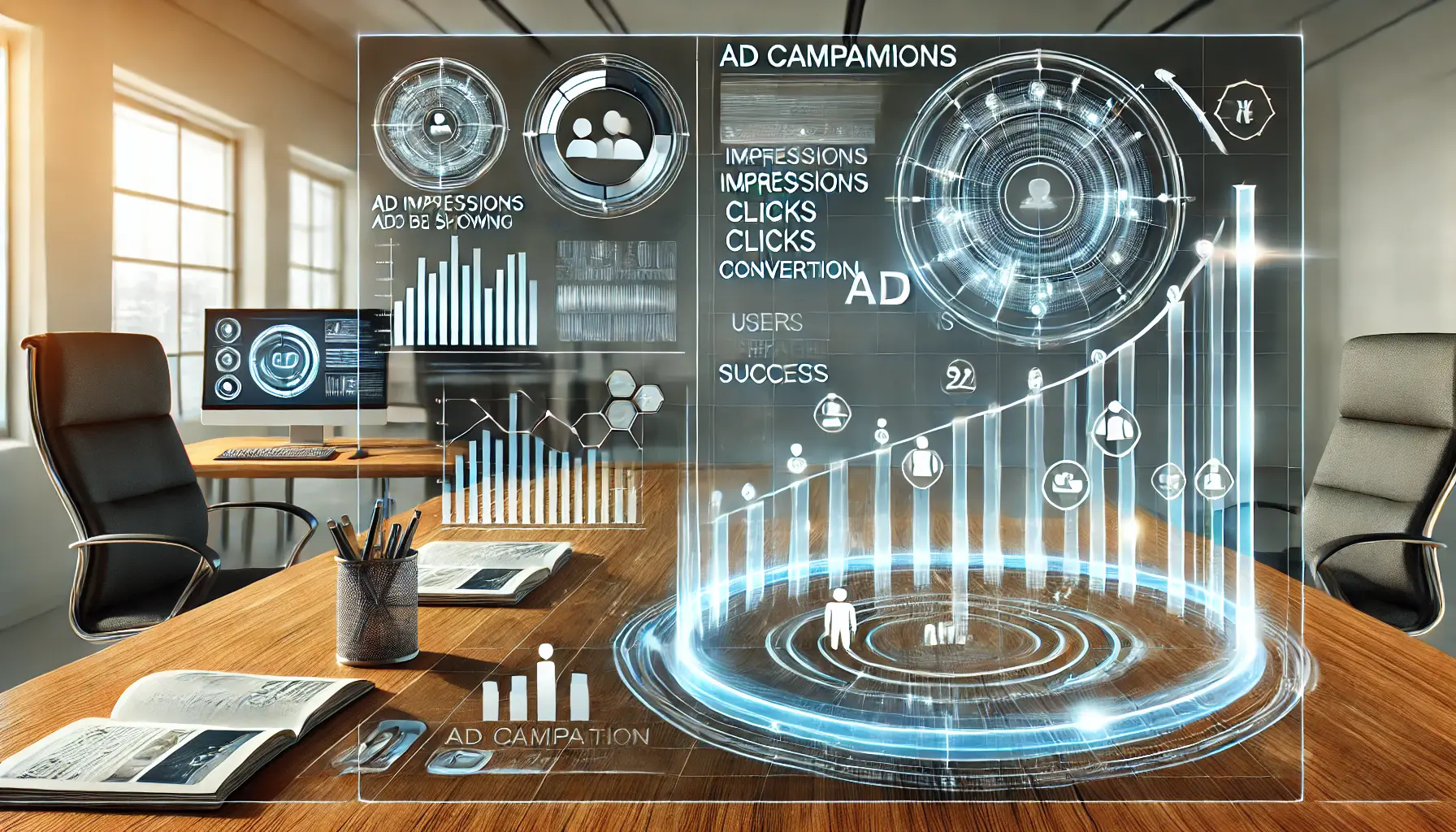
A visual representation of how ad impressions contribute to campaign success.
Importance of Impressions to Campaign Success
Impressions are among the most basic metrics that give reach to your campaigns.
A high count of impressions means your ads are being viewed by many users, which is essential for brand awareness.
On the other hand, if your impressions are not converting into clicks, that may be a signal that your ad copy, targeting, or overall campaign strategy needs improvement.
Are you giving enough attention to ad impressions?
Do you have other campaign types that can enhance your ad visibility?
Understanding these metrics is the first step toward optimizing ad performance.
Ad impressions are fundamental to understanding your ad’s reach, but they are just the starting point of user engagement. Maximizing impressions doesn’t guarantee success; it needs to be coupled with a strong overall campaign strategy.

A representation of the process of optimizing ad impressions to maximize reach.
Optimizing Ad Impressions for Maximum Reach
Optimizing ad impressions for maximum reach requires thoughtful strategy, understanding your audience, and campaign optimization in Google Ads.
While increased ad impressions improve the chances of engagement and conversions, their optimization involves more than just visibility.
It is essential that your ads appear at the right place, time, and to the right user.
Let’s talk about the best practices for achieving a high volume of ad impressions without violating Google Ads policies.

A representation of key methods to improve ad impressions, such as bid optimization and ad scheduling.
Best Ways to Improve Ad Impressions
The optimization of ad impressions starts by setting up your ads to display more frequently and consistently.
Here are the key ways to do that:
- Bid Optimization: Higher bids often yield better ad placements and increased impressions.
- Ad Scheduling: Schedule your ads to appear during peak times when your target audience is more active. Analyze your historical data to determine the best time slots for your ads.
- Targeting Broad Match Keywords: Using broad match keywords can capture a wider audience, increasing the chances of your ads appearing for various search queries.
- Expanding Geographic Targeting: Targeting more geographic locations increases the chances of your ads being shown to more users.
- Responsive Search Ads (RSA): These ads allow for multiple headlines and description combinations, increasing the likelihood of your ad appearing in search results.
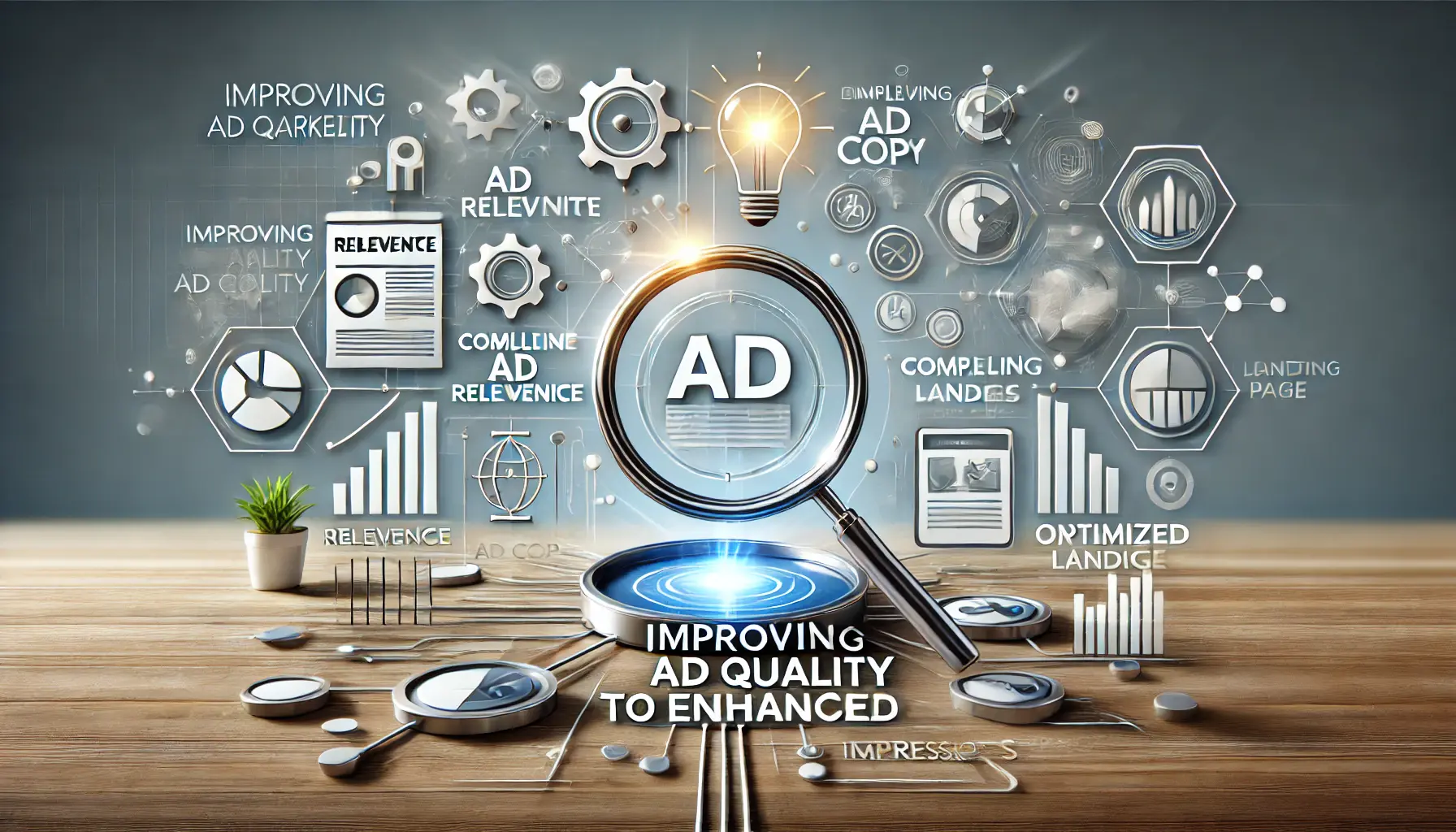
A representation of how improving ad quality can enhance impressions through relevance, copy, and landing page optimization.
Improving Ad Quality to Enhance Impressions
Although increasing bids and using broad keywords can help, improving the overall quality of your ads is critical to maximizing ad impressions.
Google rewards high-quality ads with better positioning and higher impression counts.
Here’s how you can improve your ad quality:
- Ad Relevance: Ensure your ad copy aligns with the keywords you are targeting. High relevance between your ad and the search query improves your Quality Score, leading to more impressions.
- Compelling Ad Copy: Create persuasive, relevant ad copy that resonates with your audience. Strong calls-to-action (CTAs) can increase click-through rates (CTR) and overall ad performance.
- Optimized Landing Pages: Make sure your landing page is relevant to the ad and offers a seamless user experience. A well-optimized landing page improves your ad’s Quality Score, resulting in more impressions.
- Mobile Optimization: With more people using mobile devices, ensure that your ads and landing pages are fully optimized for mobile to capture more impressions from this audience.
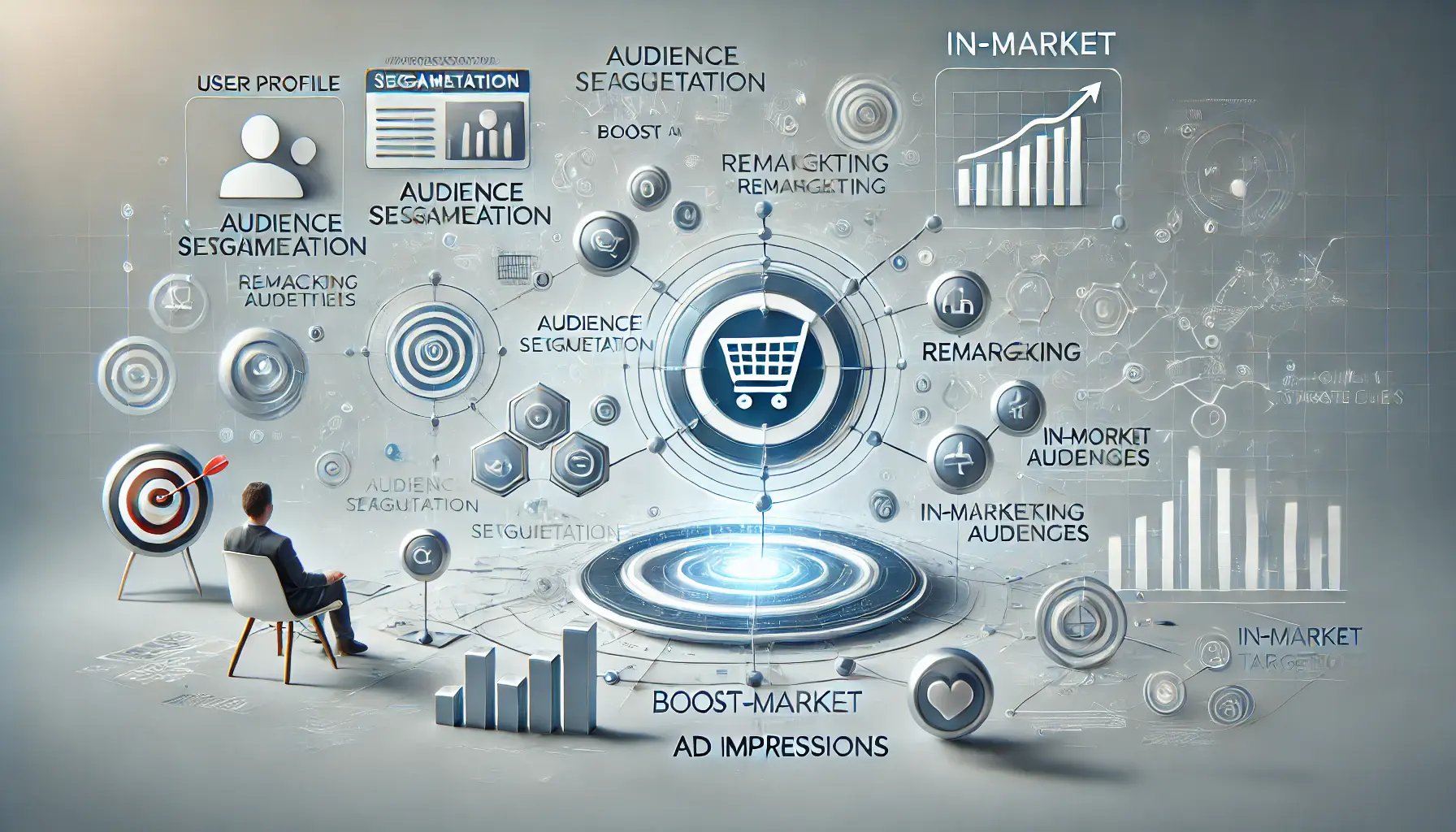
A representation of targeting strategies like audience segmentation, remarketing, and in-market targeting to boost impressions.
Targeting Strategies to Boost Impressions
Targeting the right audience is essential for increasing ad impressions.
Consider these targeting strategies to boost impressions:
- Audience Segmentation: Segment your audience into smaller groups based on interests, demographics, or online behaviors. This allows you to reach more specific audiences and gain more impressions.
- Remarketing: Use remarketing campaigns to target users who have previously interacted with your website. These users are more likely to engage with your ads, leading to higher impressions.
- Custom Intent Audiences: Target users who have shown interest in your product or service through their search history to improve ad impressions.
- In-Market Audiences: Target users who are actively searching for products or services similar to yours, increasing the likelihood of impressions.

A representation of how different ad formats like text, display, video, and shopping ads contribute to ad impressions.
How Ad Formats Affect Impressions
The format of your ads plays a significant role in the number of impressions they receive.
Different formats perform differently across platforms:
- Text Ads: These are the most common in search campaigns, and optimizing text ads with relevant headlines and descriptions can significantly increase impressions.
- Display Ads: Image-based display ads can appear on various websites and apps, increasing the likelihood of impressions across Google’s Display Network.
- Video Ads: Video ads are highly engaging and can generate a large number of impressions, especially on platforms like YouTube.
- Shopping Ads: For eCommerce businesses, shopping ads can appear in search results and Google Shopping, leading to more impressions for product-specific searches.
Are you taking advantage of these best practices and strategies to reach more users?
Maximizing impressions doesn’t happen overnight, but by implementing these steps, you’ll be on your way to better visibility and improved results for your Google Ads campaigns.
Ad impressions should be optimized by targeting the right audience at the right time, ensuring that the ads are as relevant as possible to generate meaningful engagement.
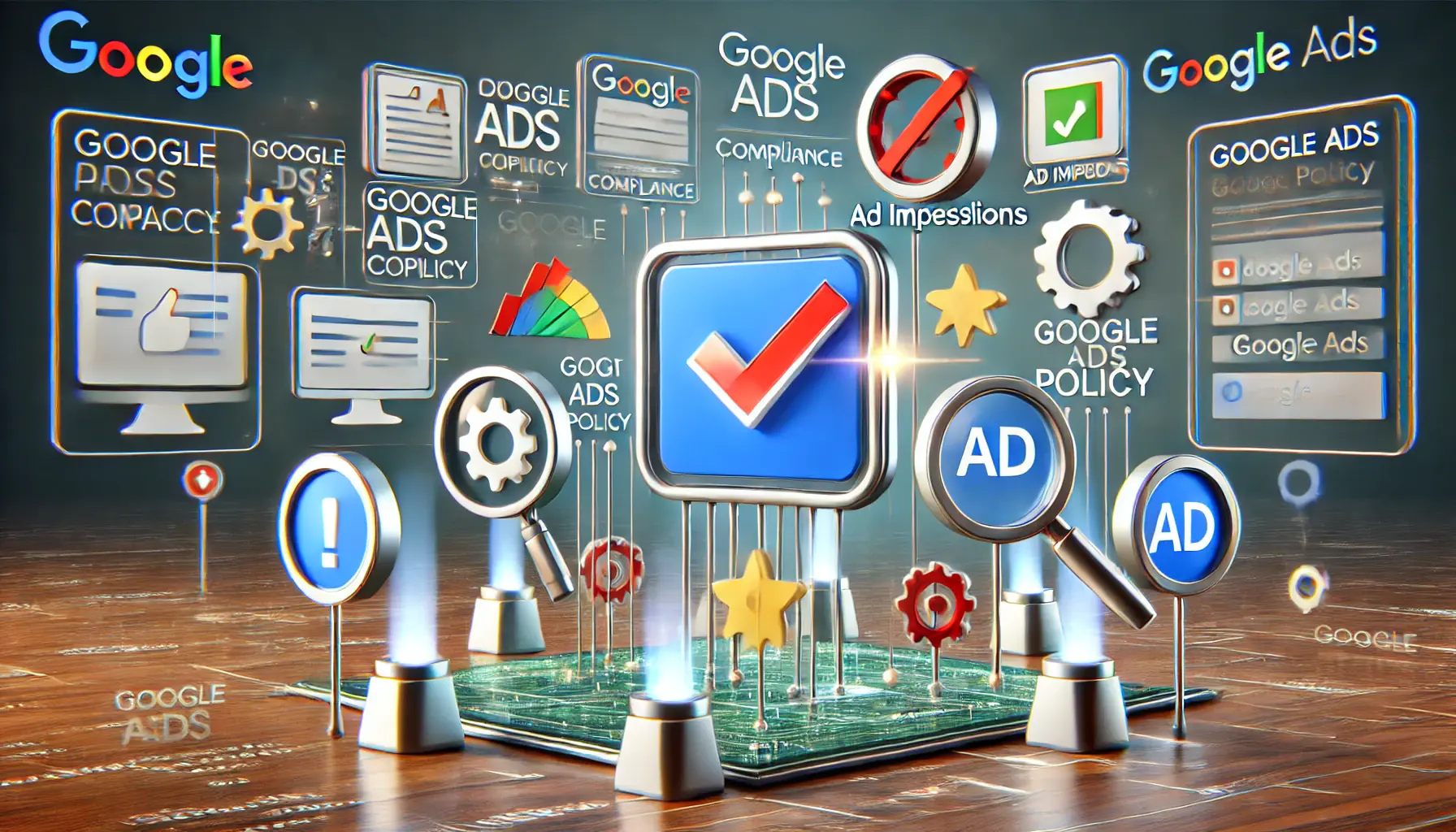
A representation of ad impressions linked with compliance to Google Ads policies, focusing on adherence and protection against violations.
Ad Impressions and Compliance with Google Ads Policy
While optimizing ad impressions is important for campaign success, it is equally important not to violate any of Google Ads’ policies.
Violating these policies can lead to penalties, including reduced ad impressions or, in the worst-case scenario, account suspension.
Google Ads specifies how advertisers should structure and run their campaigns to ensure fairness, relevance, and transparency on the platform.
In this section, we review major Google Ads policies related to ad impressions and how you can avoid violations that could harm your campaigns.
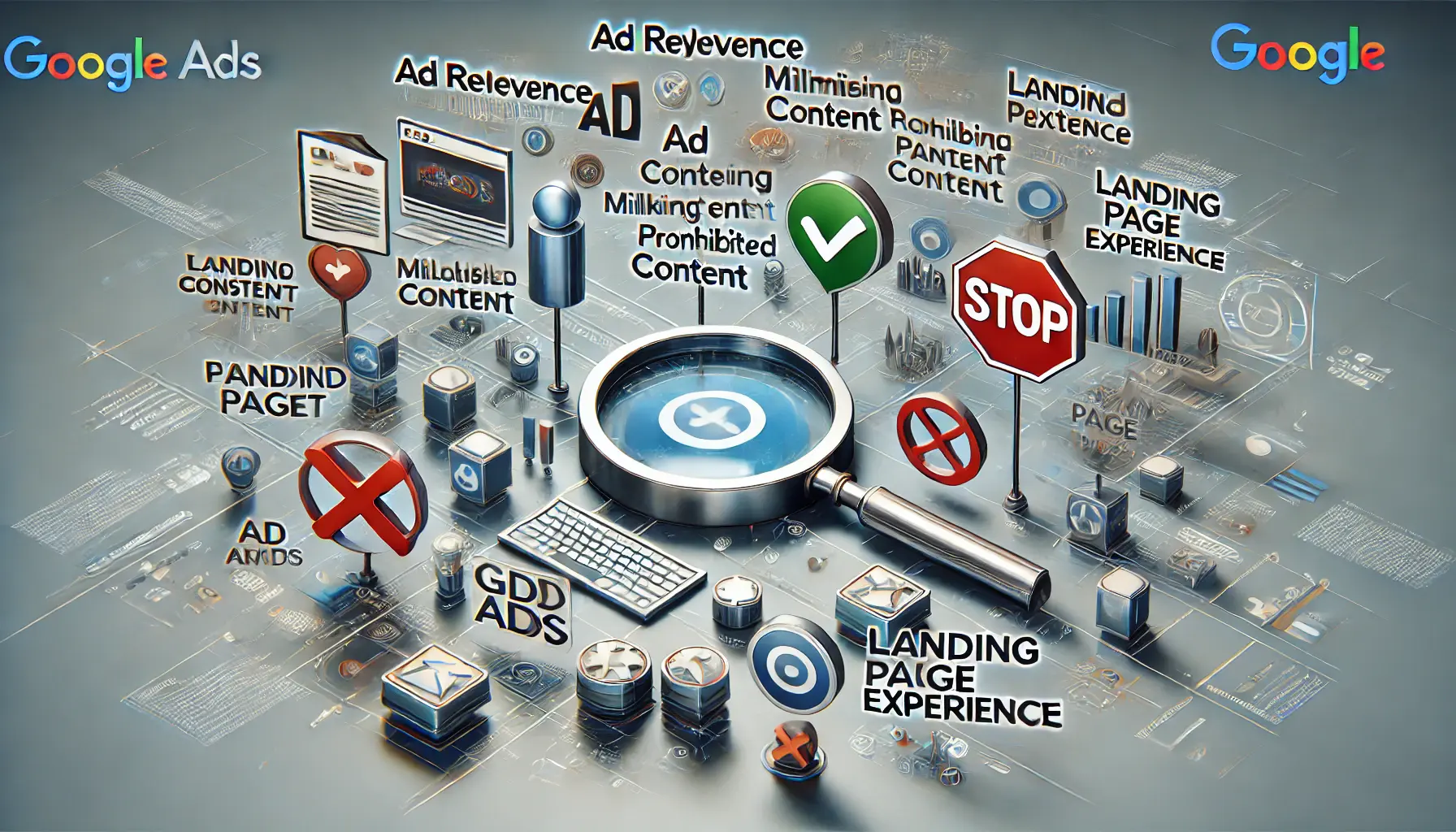
A representation of important Google Ads policies such as relevance, prohibited content, and landing page experience that impact ad impressions.
Key Google Ads Policies that Impact Ad Impressions
- Ad Relevance: Ads must be relevant for the keywords and desired audiences. Irrelevant ads may serve less frequently or not be approved at all.
- Misleading Content: Misleading content is strictly prohibited in Google text ads. This includes exaggerated claims, clickbait, or fake promises. Ads containing misinformation will likely receive fewer impressions or be removed.
- Prohibited Content: There are restrictions on certain types of content, including harmful products, illegal services, and inappropriate language. Ads containing such content will be disapproved, and repeated violations may result in account suspension.
- Landing Page Experience: Google rewards ads when users are directed to optimized landing pages relevant to their search query. Ads leading to poor or irrelevant landing pages will result in fewer impressions.
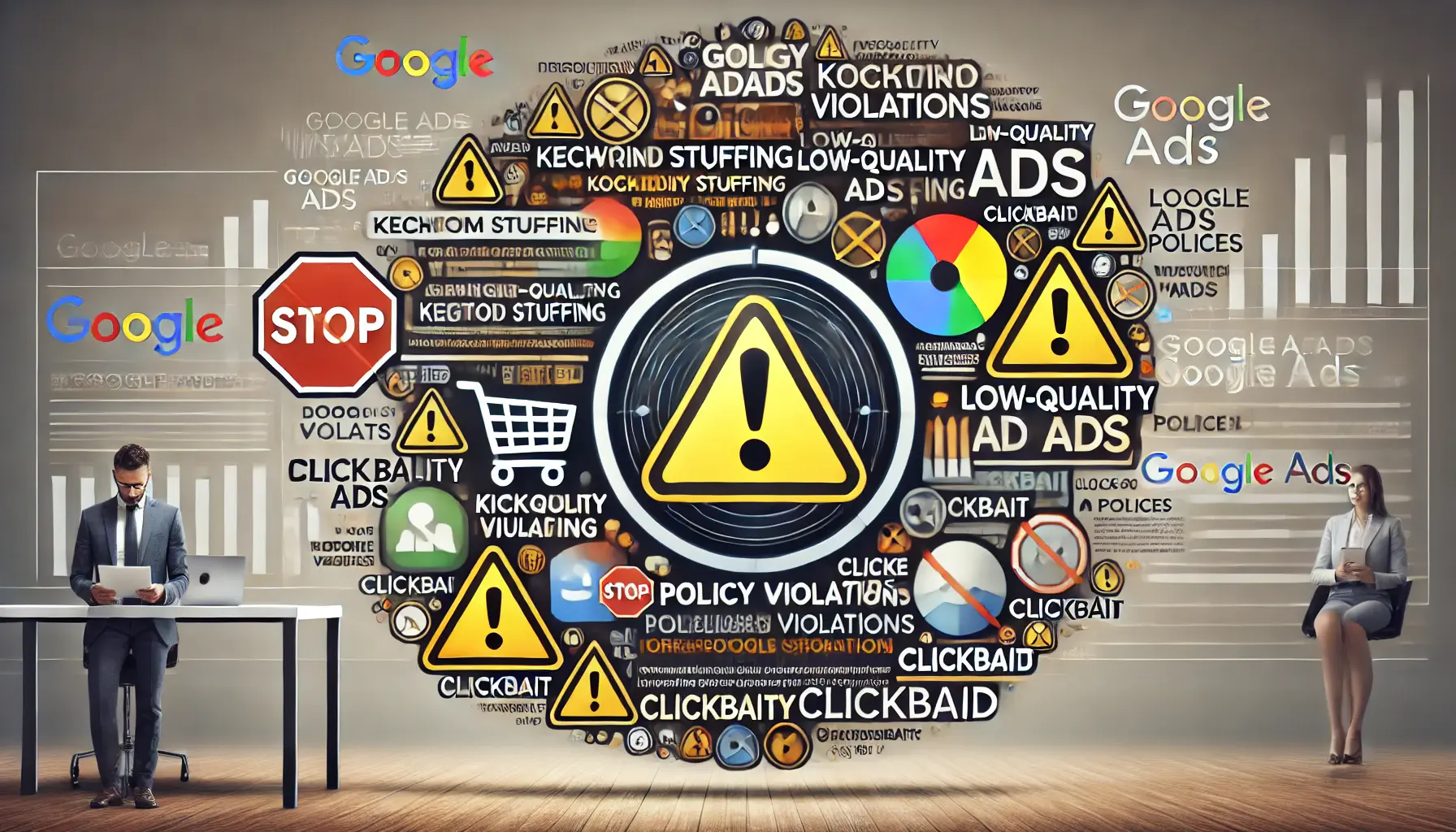
A representation of how policy violations like keyword stuffing, clickbait, and low-quality ads can negatively impact ad impressions.
Policy Violations That Impact Impressions
Advertisers need to be aware of policy violations that can lead to reduced ad impressions:
- Keyword Stuffing: Overusing keywords in ad copy can result in poor relevance, which reduces your Quality Score and leads to fewer impressions.
- Low-Quality Ads: Ads with low-quality scores, poor copywriting, irrelevant keywords, or misleading information will have reduced impressions.
- Clickbait Tactics: Using sensational or misleading headlines against Google’s policy results in fewer impressions.
- Repeated Violations: Continuous violations of Google’s ad policies may result in account suspension. If your account is suspended, ad impressions will stop, causing potential financial damage to your business.

A representation of strategies to avoid penalties for ad impressions through compliance and monitoring.
Avoiding Penalties for Ad Impressions
Advertisers should follow all Google Ads guidelines to maximize their ad impressions.
Here are some tips for staying compliant:
- Review Google’s Advertising Policies Regularly: Stay up to date with the latest changes in Google Ads policies to avoid unintended violations.
- Create High-Quality Ads: Write clear, relevant, and engaging ad copy that aligns with targeted keywords and user intent.
- Optimize Landing Pages: Ensure your landing page is fast, mobile-friendly, and directly relevant to the ad content.
- Monitor Your Campaign Performance: Use Google Ads’ reporting tools to track the performance of your ads, including Quality Score and impressions. Adjust your campaigns as needed.
- Fix Disapproved Ads Promptly: If an ad gets disapproved, resolve the issue immediately to avoid further penalties that could affect your entire campaign.

A representation of the importance of staying compliant with Google Ads policies using symbols for protection, compliance, and ad review.
Staying Compliant with Google Ads Policies
Staying compliant with Google Ads policies not only helps avoid penalties but also improves overall ad performance.
Google rewards ads that offer good user experiences with better placements, higher Quality Scores, and increased impressions.
By focusing on relevance, transparency, and quality, you can optimize your campaigns to fit within Google’s guidelines while maximizing your ad impressions.
Are you up to date on the latest Google Ads policy changes?
Are your ads fully compliant?
Ensuring your campaigns are aligned with these guidelines will help you avoid penalties and ensure maximum ad impressions.
Violating Google Ads policies can lead to a reduction in impressions or even account suspension, making it crucial to adhere to Google’s rules to maximize campaign performance.

A representation of tools and metrics used to analyze ad impressions in digital marketing.
Analyzing Ad Impressions: Metrics and Tools
To ensure that your ad impressions are optimized and increased, you need to constantly analyze them using proper metrics and tools.
Ad impressions themselves can be vanity metrics; it’s only by understanding how your ads are performing that you can gain meaningful insights to improve their performance.
Google Ads offers a wide array of metrics and tools for evaluating a campaign’s effectiveness.
In this section, we will review the most important metrics you should pay attention to and the tools at your disposal to make more effective decisions related to ad impressions.
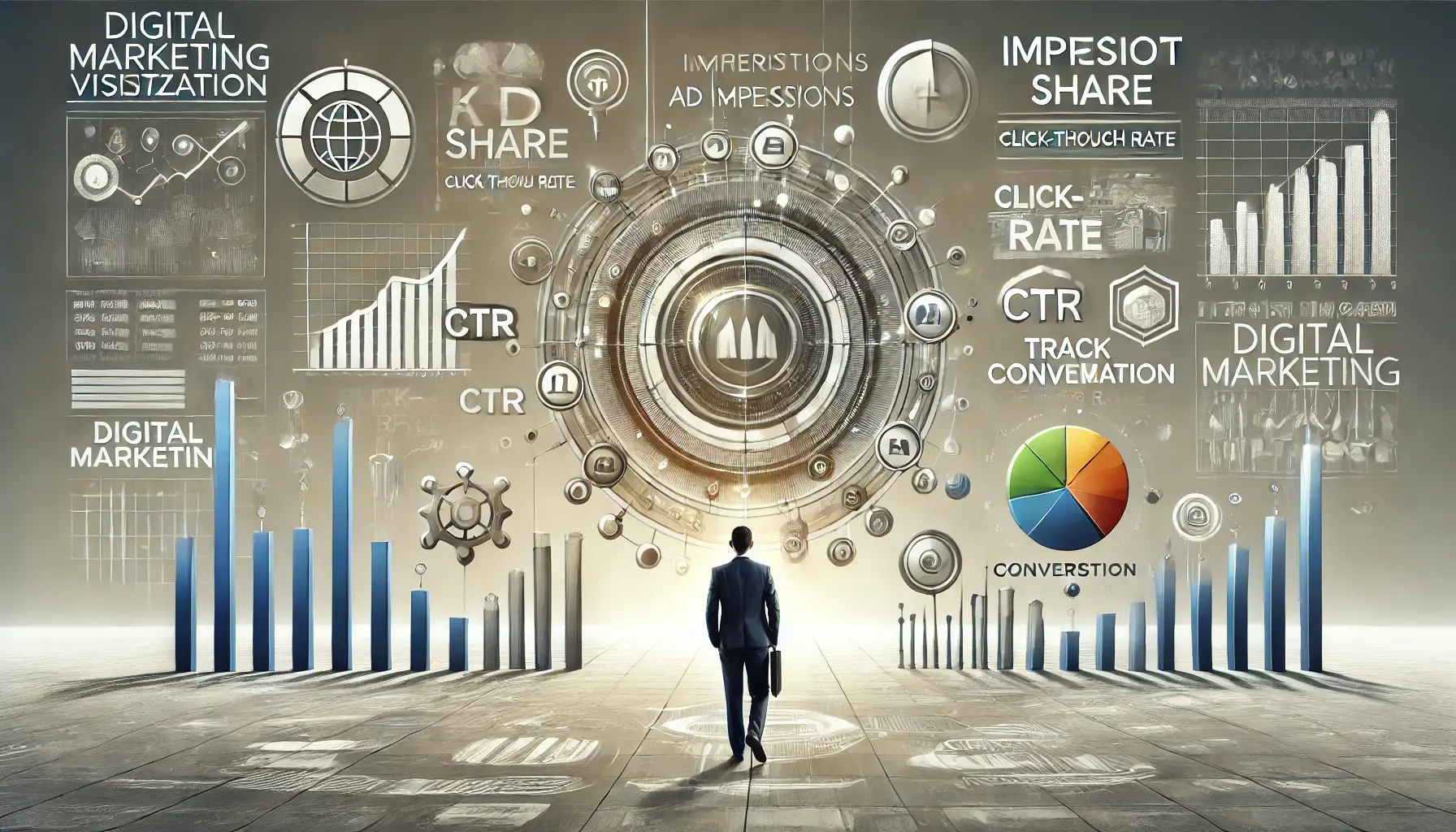
A representation of the key metrics used to track ad impressions in digital marketing.
Key Metrics to Track Impressions
The metrics behind your ad impressions are essential for improving your Google Ads campaigns.
Here are the key metrics you should be tracking:
- Impression Share: This metric tells you the percentage of impressions your ads received compared to the total available impressions in the market. A higher Impression Share means your ads are doing well and appearing frequently.
- Impression (Absolute Top) %: This metric shows the percentage of your impressions that appear at the top of the search results, attracting more attention from users.
- Search Lost Impression Share (Budget): This metric reveals how often your ads didn’t appear due to budget constraints. If this number is high, it may be time to adjust your budget.
- Search Lost Impression Share (Rank): This metric indicates the percentage of impressions lost due to poor ad rank. You can recover these impressions by improving ad relevance and bidding strategies.
- Click-Through Rate (CTR): While CTR does not relate directly to impressions, it is crucial to track since it shows how often users click on your ad after viewing it. Low CTR with high impressions may signal a problem with your ad copy or targeting.
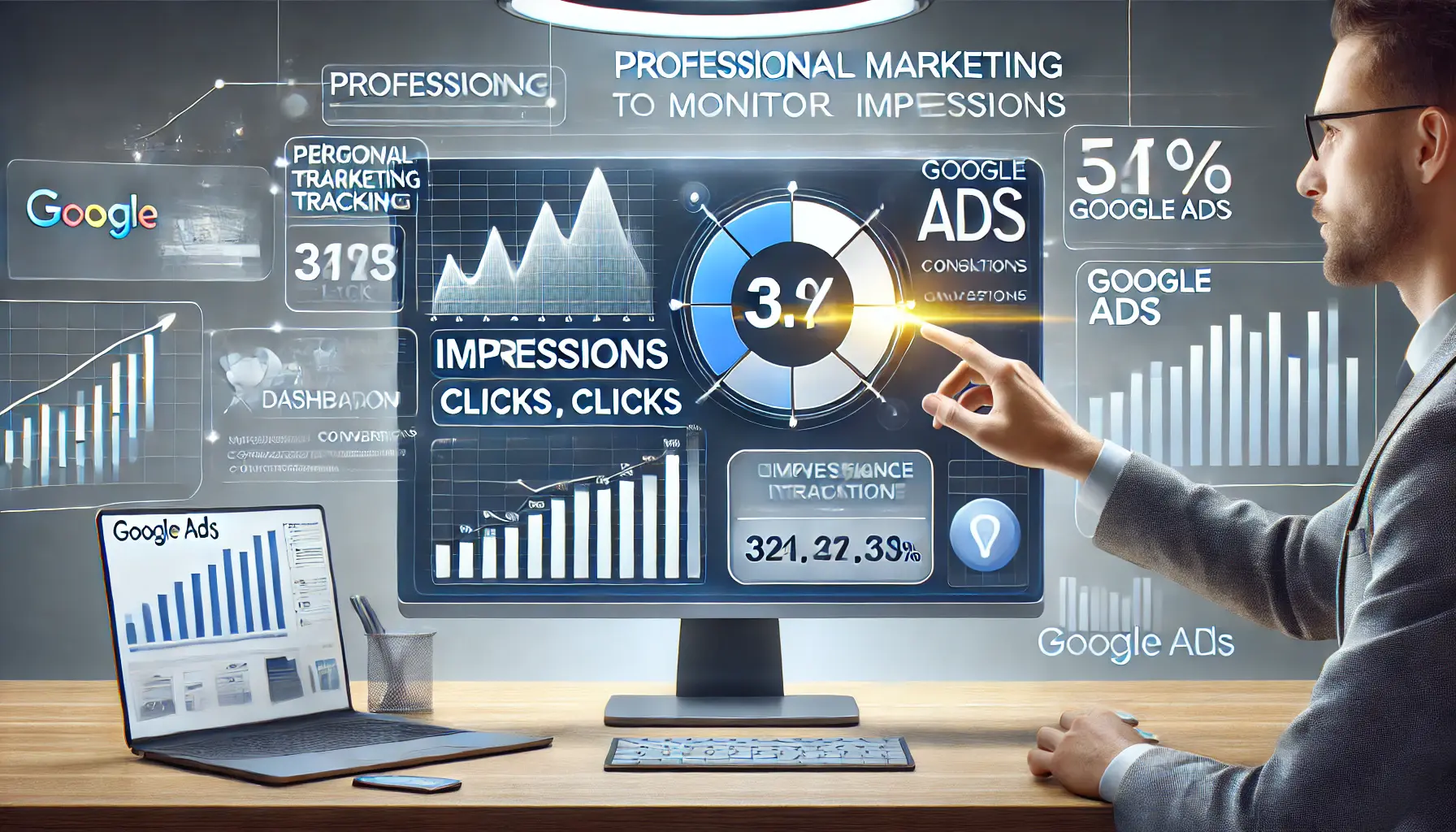
A representation of how the Google Ads dashboard helps monitor impressions and track campaign performance.
Using Google Ads Dashboard to Monitor Impressions
The Google Ads dashboard offers several features to help advertisers monitor their ad impressions and related metrics:
- Performance Reports: Use performance reports to track impressions, clicks, conversions, and other metrics. These reports can be customized based on the specific campaign objectives.
- Search Terms Report: This report shows the search queries that triggered your ads. Analyzing this report allows you to refine your keyword targeting and optimize for more impressions.
- Ad Position Reports: Ad position reports provide insights into where your ads are appearing on the search results page, helping you understand visibility and impression share.
- Auction Insights: This tool compares your ad performance to that of other advertisers bidding on similar keywords, offering insights into how you can improve your impression share.

A representation of third-party tools used for impression analysis, including SEMrush, Ahrefs, SpyFu, and WordStream.
Third-Party Tools for Impression Analysis
While Google Ads provides a powerful set of native tools, several third-party tools can complement your analysis and provide deeper insights into your ad impressions:
- SEMrush: SEMrush offers advanced competitive analysis, allowing you to see how your ads compare to competitors in terms of impressions and visibility. This can help inform your strategy to gain more visibility.
- Ahrefs: Known primarily for SEO, Ahrefs also provides tools for analyzing ad performance and identifying opportunities to improve impressions.
- SpyFu: SpyFu enables you to see the keywords your competitors are bidding on, along with the impressions they are generating. This information can help you adjust your strategy for better visibility.
- WordStream: WordStream offers tools for PPC optimization, including features for tracking ad impressions and improving overall campaign performance.

A representation of common mistakes in ad impression analysis, such as flawed data interpretation and poor audience targeting.
Common Mistakes When Analyzing Impressions
Despite access to robust tools and data, advertisers often make mistakes when analyzing impressions.
Here are some common pitfalls to avoid:
- Focusing Only on Impressions: While high impressions are important, they are only part of the equation. You must also track CTR, conversions, and overall ad effectiveness.
- Ignoring Impression Share: Many advertisers overlook impression share, but a low impression share might indicate that your ads aren’t being seen by as many potential customers as they could be.
- Poor Audience Targeting: Poorly targeted audiences lead to irrelevant impressions, which don’t translate into clicks or conversions. Ensure your targeting is precise and aligned with your campaign goals.
- Not Adjusting Budgets: If you’re losing impressions due to budget constraints, increasing or reallocating your budget to more effective campaigns can help regain lost visibility.
Are you using the right metrics and tools to track your ad impressions?
By leveraging the right data and avoiding common mistakes, you can optimize your campaigns and maximize the value of your ad impressions.
Google Ads provides numerous tools like performance reports and search term reports to track ad impressions and optimize your campaigns effectively.

A representation of the future role of ad impressions, focusing on AI-driven optimization, viewability, and evolving metrics.
Future Trends: The Emerging Role of Ad Impressions
With the growth and evolution of digital advertising, the role of ad impressions is also undergoing significant changes.
Advances in technology, changing consumer behavior, and new privacy regulations are reshaping how ad impressions are tracked and optimized.
Staying ahead of these trends is crucial for maintaining competitiveness and optimizing ad performance in the future.
In this section, we explore some of the key trends shaping the future of ad impressions.
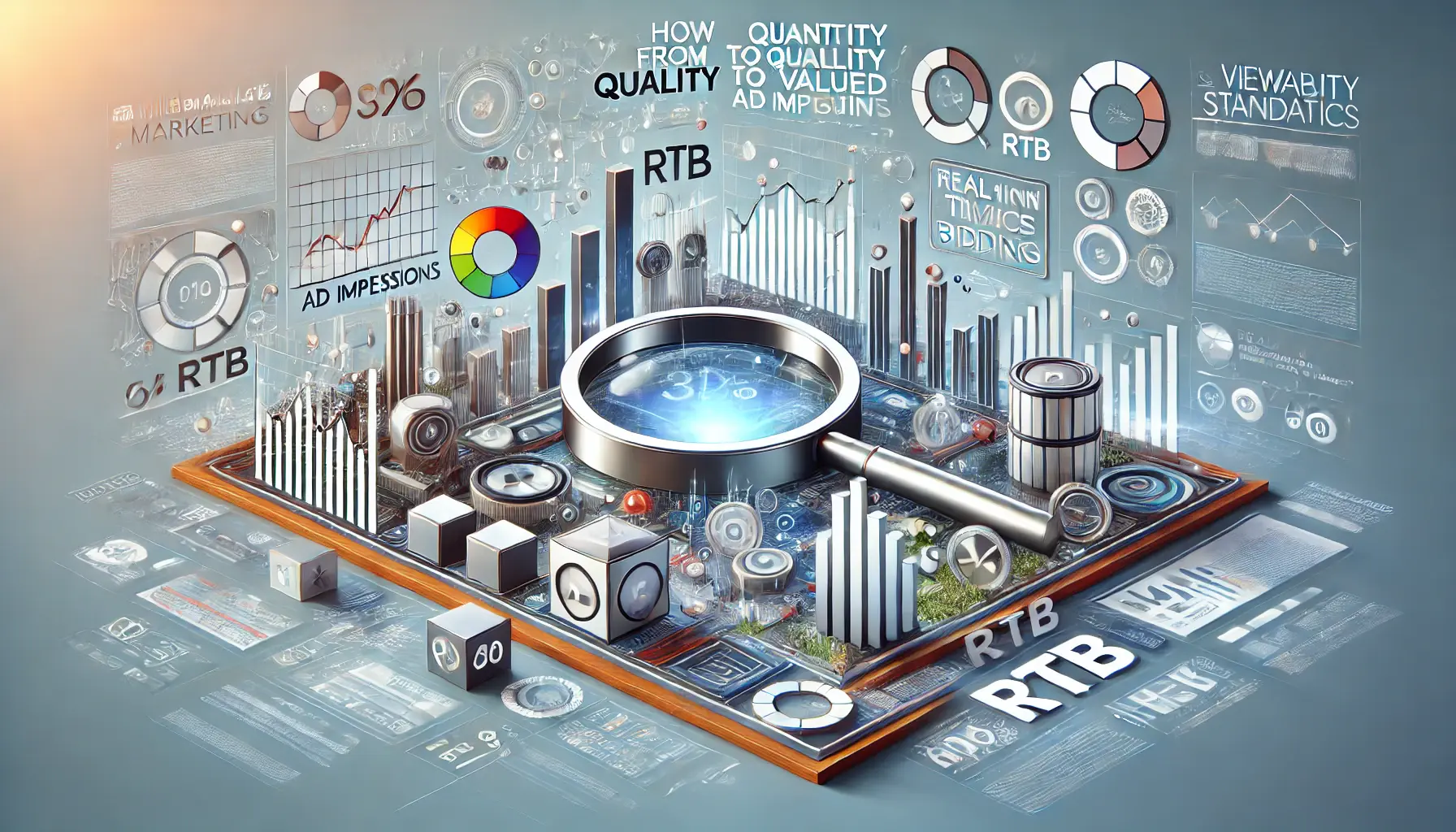
A representation of how ad impressions are evolving from quantity to quality, focusing on modern advertising trends.
How Ad Impressions are Shifting in Digital Advertising
Traditionally, ad impressions have been viewed as a volume metric where success was measured by how many times an ad was shown.
Nowadays, advertisers emphasize quality over quantity.
The shift from mere exposure to actual engagement and interaction is transforming how impressions are valued in digital campaigns:
- Viewability Standards: Advertisers are increasingly focusing on viewable impressions where ads are actually seen by users instead of just being displayed. This shift is in response to issues like ad fraud and non-viewable ads that impact performance.
- Engagement Metrics: Engagement is becoming just as important as impressions. Advertisers now monitor how long users spend viewing their ads and whether those impressions lead to actions such as clicks, video views, or conversions.
- AI-Driven Optimization: AI is optimizing impressions in real-time, driving better user experiences and improving advertiser value. AI can process large datasets in real-time, identifying patterns in user behavior to make decisions that improve ad performance.

A representation of how AI enhances ad impressions through real-time optimization and predictive analytics.
The Impact of AI on Ad Impressions
AI is transforming how ad impressions are optimized and delivered.
Here’s how AIArtificial Intelligence, used to optimize ads in real-time based on data analysis. is shaping the future of ad impressions:
- Personalized Ad Delivery: AI-driven systems can serve personalized ads to users based on their browsing habits, past interactions, and interests. This ensures that the right ad is shown to the right user at the right time, increasing the value of impressions.
- Real-Time Bidding (RTB): AI in Real-Time Bidding platforms optimizes ad impressions by adjusting bids in real-time. Advertisers can bid more competitively for high-value impressions while lowering their spend on low-value impressions.
- Predictive Analytics: AI can predict which users are most likely to engage with an ad based on their behavior, ensuring impressions are not wasted on unlikely conversions. This improves ad targeting and overall campaign efficiency.

A representation of the impact of privacy laws on ad impressions, focusing on data protection and regulatory compliance.
Privacy Laws and Their Effect on Impressions
With increasing consumer concerns around privacy and the introduction of regulations like the General Data Protection Regulation (GDPRGeneral Data Protection Regulation, a privacy law in the European Union.) and California Consumer Privacy Act (CCPACalifornia Consumer Privacy Act, a privacy law in California, USA.), the way ad impressions are tracked and reported is changing.
These regulations are shaping the future of digital advertising by restricting the types of data advertisers can collect:
- Third-Party Cookie Phase-Out: Major web browsers are phasing out third-party cookies, which traditionally allowed advertisers to track user behavior and optimize impressions. As cookies disappear, advertisers are shifting to first-party data and alternative tracking methods.
- Consent-Driven Advertising: New privacy regulations are pushing advertisers to obtain explicit consent from users before collecting data. This reduces the volume of data available for targeting but increases the quality of impressions, as users who opt in are more likely to engage with the ads.
- Contextual Advertising: With reduced access to user data, many advertisers are turning to contextual advertising, where ads are targeted based on the content users are viewing rather than their personal data. This ensures compliance with privacy laws while still generating valuable impressions.

A representation of how ad impressions will evolve in a cookieless future, focusing on privacy, first-party data, and contextual targeting.
Ad Impressions in a Cookieless Future
As the industry moves toward a cookieless future, advertisers will need to adapt to new ways of tracking and optimizing impressions.
Without third-party cookies, ad impressions will rely on first-party data, AI, and contextual targeting:
- First-Party Data Usage: Advertisers will need to focus on collecting and utilizing first-party data, such as data from their websites, apps, and CRM systems, to effectively target users and optimize impressions.
- Contextual Targeting: Instead of relying on user data, contextual targeting places ads relevant to the content the user is currently consuming. This will become more prominent as privacy concerns grow.
- Universal Identifiers: New tracking methods, such as Universal Identifiers, are being developed to replace cookies. These identifiers allow advertisers to track users across devices and platforms while maintaining compliance with privacy regulations.
Are you prepared for the changes shaping the future of ad impressions?
Understanding the evolving role of impressions in digital advertising and adapting to new trends will keep you ahead and ensure your campaigns succeed in the long run.
The shift from focusing on impression volume to emphasizing viewability and engagement is reshaping how advertisers optimize their ad impressions in the future.
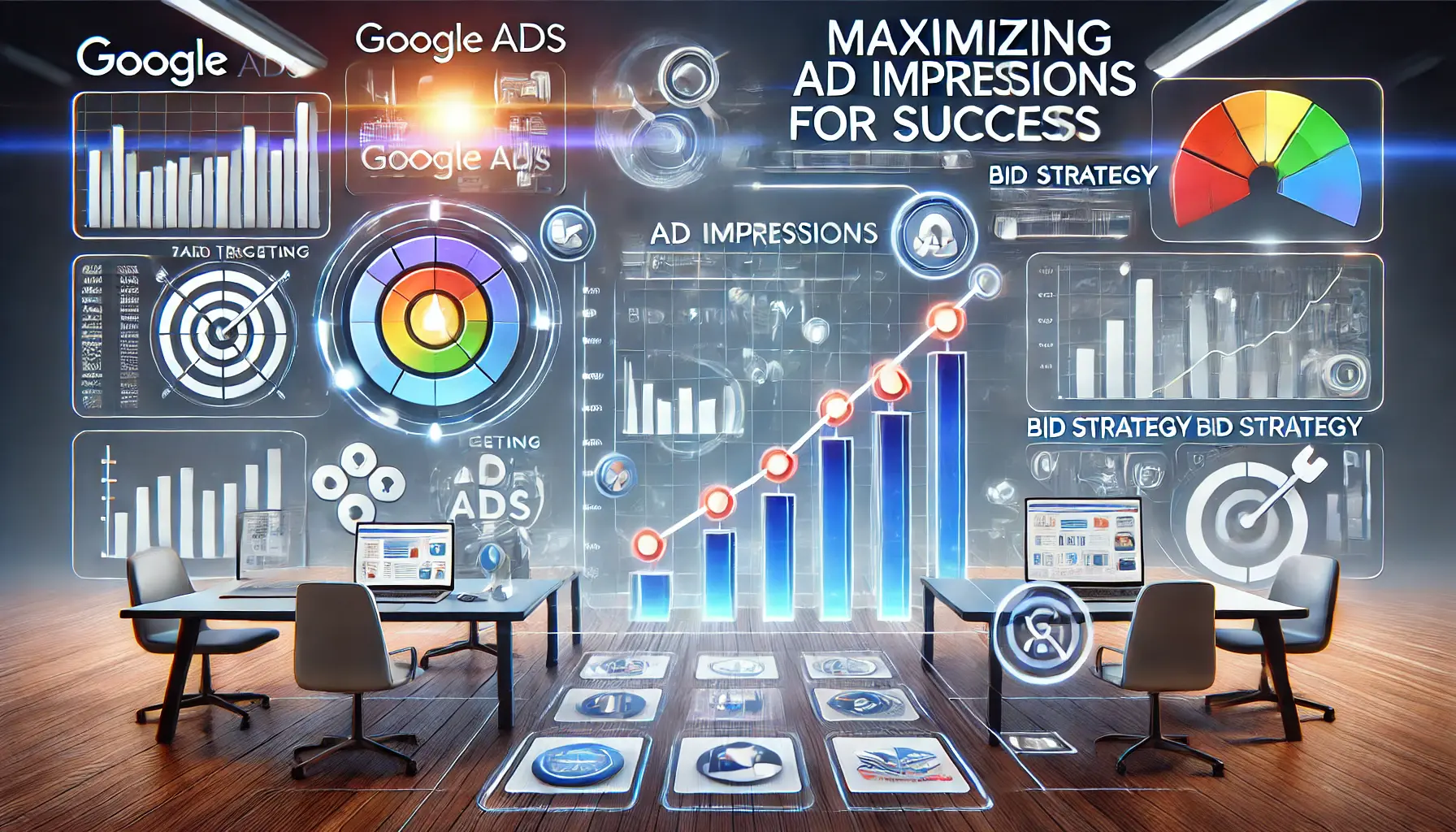
A representation of maximizing ad impressions for success with Google Ads through optimization strategies.
Maximizing Ad Impressions for Success with Google Ads
Ad impressions are critical to the success of a Google Ads campaign.
In this article, we reviewed how ad impressions work, how they can be best optimized, and how to ensure compliance with Google Ads policies to drive engagement and conversions.
By paying strategic attention to the quality and placement of impressions, advertisers can create more effective campaigns that drive superior results.
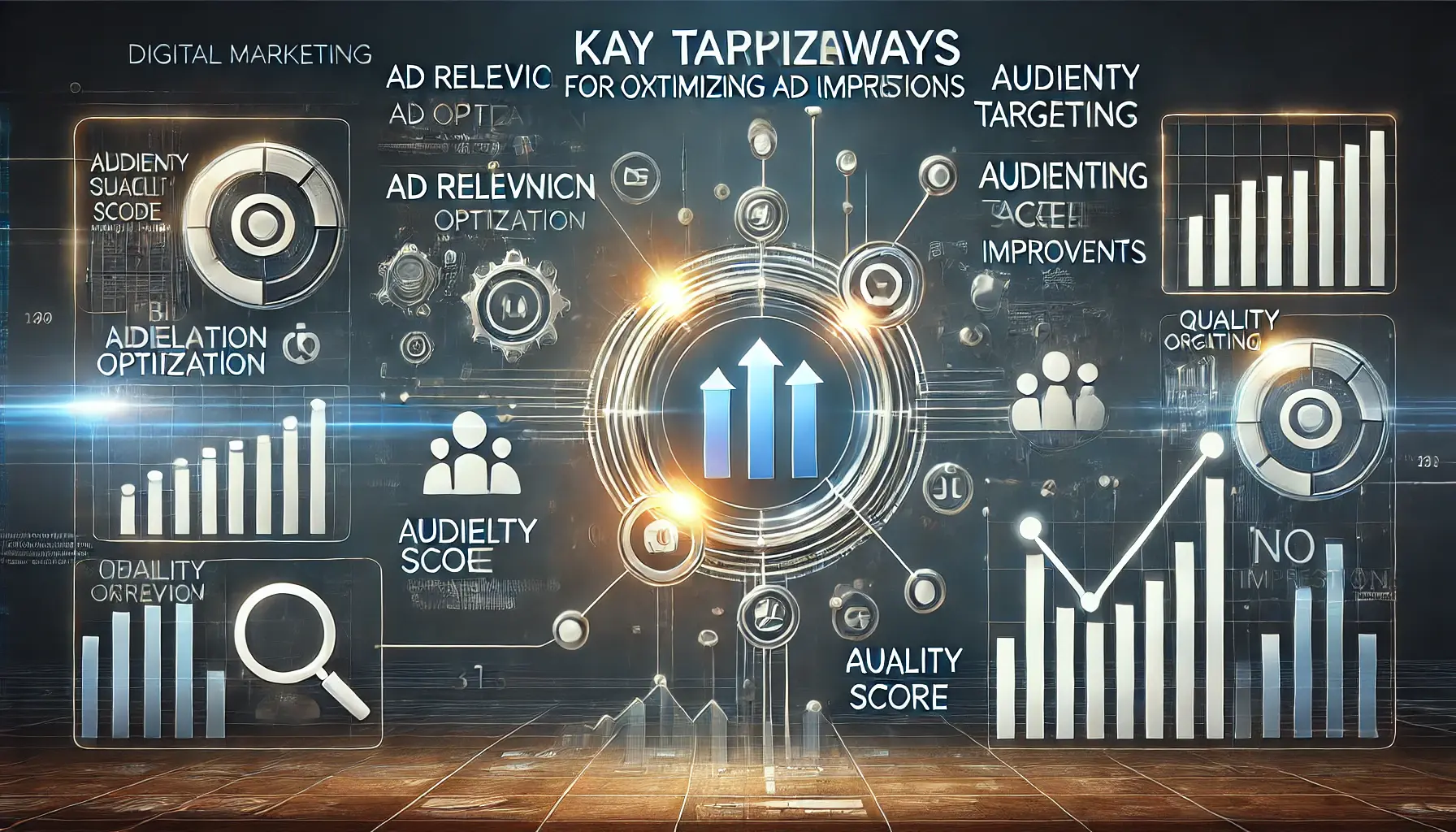
A representation of key takeaways for optimizing ad impressions, focusing on relevance, bid strategy, and audience targeting.
Key Takeaways for Optimization of Ad Impressions
Optimizing ad impressions is not just about increasing visibility; it’s about enhancing engagement and making sure your ads reach the right audience at the right time.
Here are key points to remember:
- Ad Relevance: Ads must be highly relevant to the keywords you are bidding on and the audience being targeted. This increases the chances of generating meaningful impressions and, ultimately, engagement.
- Bid Optimization: Ensure your bids are optimized for better positioning of ads in search results, which will improve impressions.
- Audience Targeting: Refine audience segments and targeting to ensure your ads are shown to users most likely to engage with them.
- Quality Score: A high Quality Score, combined with optimized ad copy and landing pages, will ensure an increase in both impressions and overall campaign performance.
- AI and Automation: Leverage AI tools to optimize ad delivery in real time, ensuring your ads are served to the most relevant users based on their behavior and preferences.

A representation of how compliance plays a crucial role in maximizing ad impressions by protecting from penalties.
The Importance of Compliance in Maximizing Impressions
Compliance with Google Ads policies is crucial for ensuring your ads are served and receive the highest possible impressions.
Violations not only decrease your impression count but may also result in penalties, such as account suspension.
Key policies to keep in mind include:
- Ad Content Compliance: Ads should not contain misleading claims, clickbait, or prohibited content.
- Landing Page Optimization: Google rewards ads that direct users to optimized landing pages, increasing impressions.
- Keyword Usage: Avoid keyword stuffing. Instead, focus on relevance between your ad copy and user search queries to improve ad performance and impressions.

A representation of how ad impressions will evolve in the future of digital advertising, driven by AI and data analytics.
Ad Impressions in the Future of Digital Advertising
The future of digital advertising is constantly evolving, shaping ad impressions with trends such as AI, privacy regulations, and the transition to a cookieless future.
Staying ahead of these changes will help you stay competitive:
- AI Optimization: AI-driven systems will continue to play a major role in optimizing ad impressions, personalizing ad delivery, and enhancing engagement.
- Privacy Regulations: With regulations like GDPR and CCPA becoming more prevalent, advertisers will need to adopt consent-driven models of advertising that prioritize user privacy.
- First-Party Data: As third-party cookies are phased out, first-party data will become a crucial tool for targeting ads and optimizing impressions effectively.
- Contextual Targeting: In the future, contextual advertising will grow in importance as advertisers focus on delivering ads based on the content users are viewing, rather than relying on user-specific data.
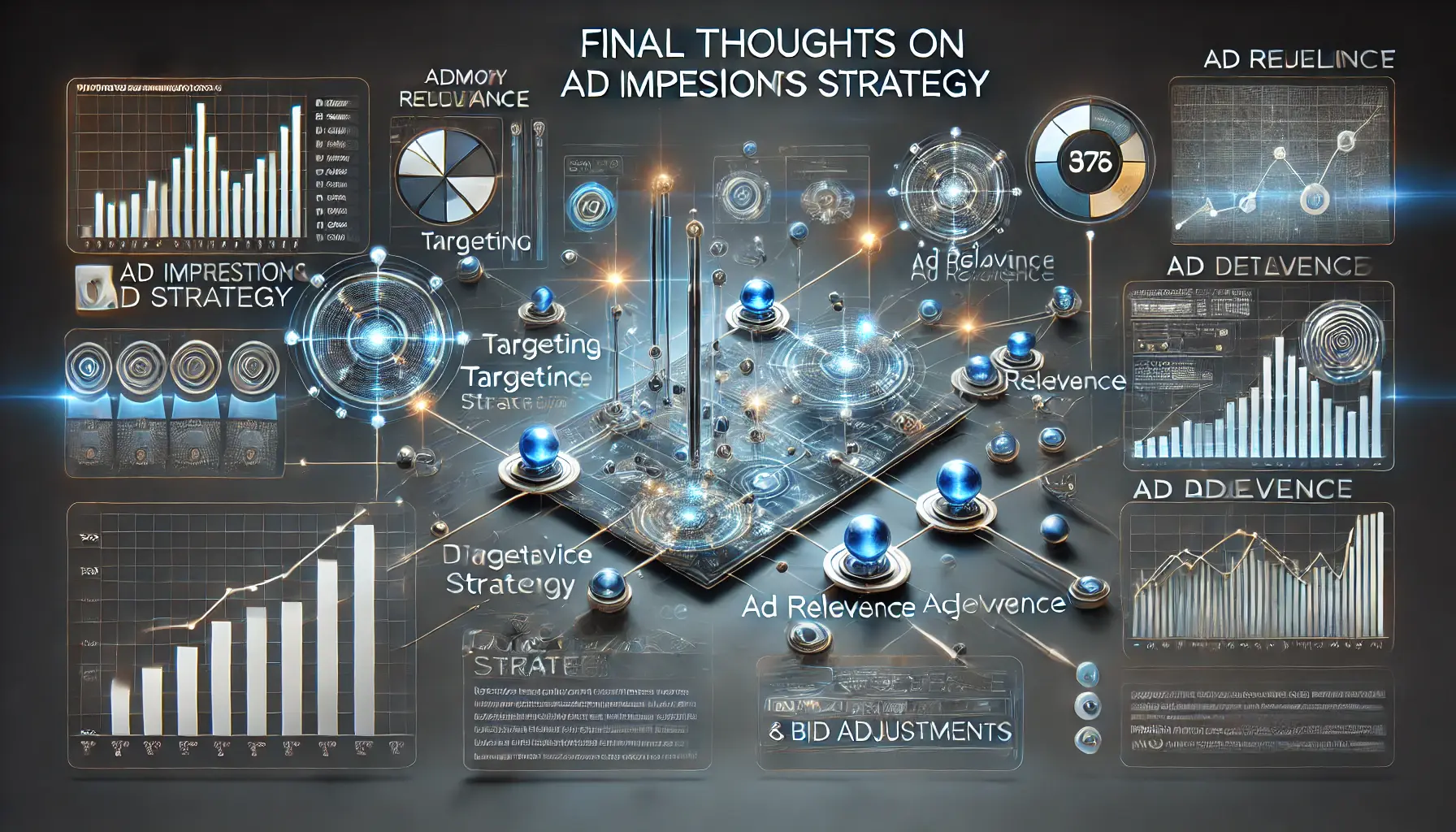
A representation of final thoughts on ad impressions strategy, focusing on optimization, targeting, and bid adjustments.
Final Thoughts on Ad Impressions Strategy
To maximize ad impressions in Google Ads, you must balance optimization techniques with compliance, while adapting to shifting trends in digital advertising.
By focusing on relevance, quality, and precise targeting, you can not only increase impressions but also drive value-driven engagement, leading to better overall performance.
As the digital landscape continues to evolve, staying informed about emerging technologies and regulatory changes is essential for long-term success.
Is it time to implement these strategies and start optimizing your ad impressions?
With the insights shared in this article, you can elevate your campaigns and ensure that your ads reach the right audience, improving your overall results.
Optimizing ad impressions involves focusing on ad relevance, bid strategies, and audience targeting while ensuring compliance with Google’s policies.
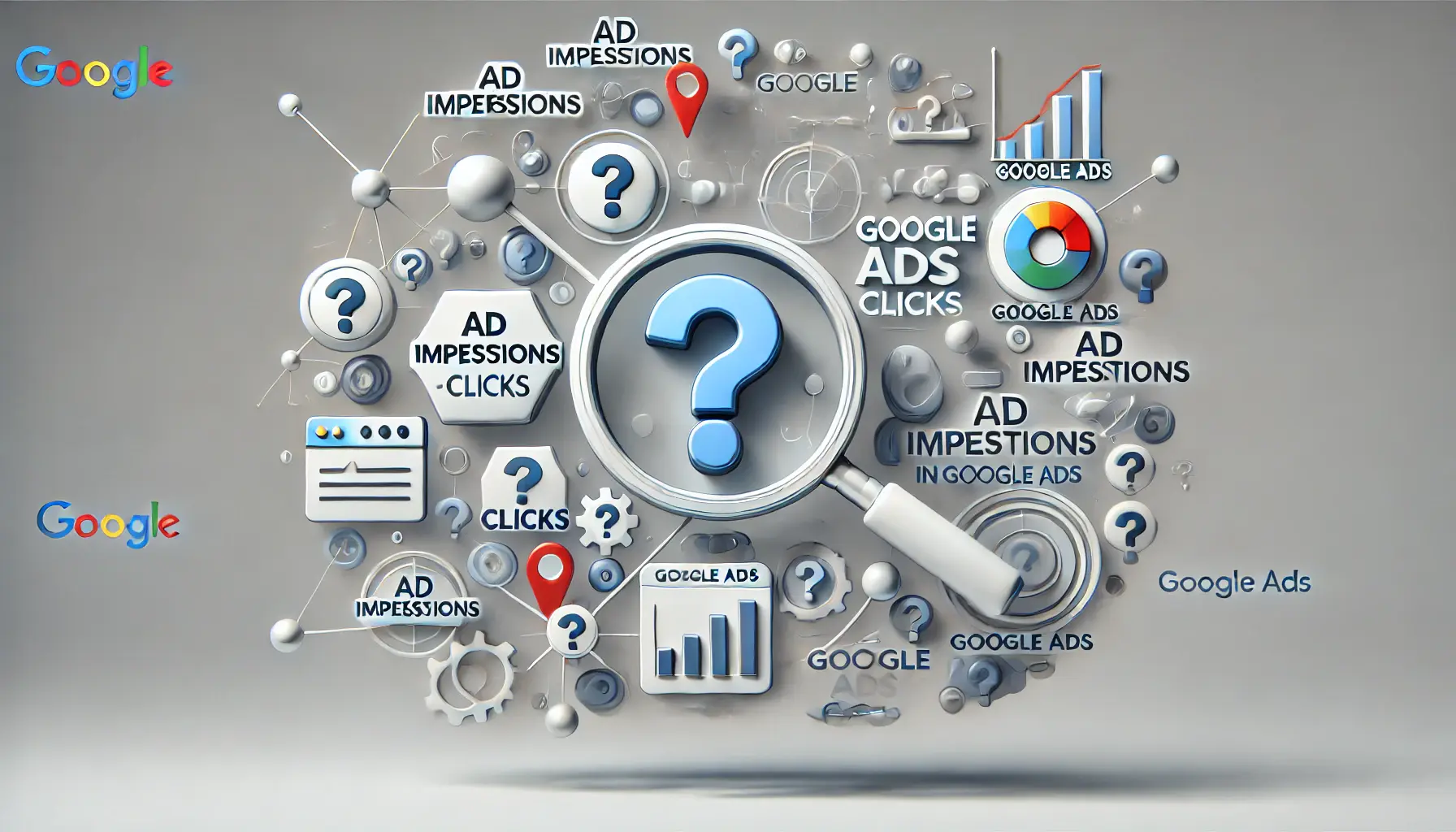
A representation of common questions about ad impressions in Google Ads, focusing on metrics such as impressions, clicks, and conversions.
Your campaigns can be managed by an agency specialized in Google Ads, check out our service page.
Common Questions About Ad Impressions in Google Ads
Here are some of the most frequently asked questions about ad impressions in Google Ads and how they relate to campaign performance.
These answers will provide you with a deeper understanding of how impressions work and how to improve them for better results.
An ad impression occurs whenever your ad appears on a user’s screen.
It demonstrates the total reach of your ad but doesn’t necessarily mean that the user interacted with or viewed the ad directly.
High impressions indicate broad reach, but they must translate into clicks and engagements for your campaign to be successful.
Optimizing for engagement alongside impressions is key to driving conversions.
A good impression share typically falls between 70-90%.
This means your ads are frequently shown and have captured a large share of the available impressions in your targeted markets.
To increase impressions, optimize your bids, improve ad relevance, and broaden your targeting.
Ensure your ad copy and keywords align with what your audience is searching for to maximize visibility.
Impressions measure how often your ad is displayed, while clicks track how many times users clicked on your ad.
High impressions with low clicks may indicate a need to refine your ad targeting or copy.
Yes, improving ad relevance increases your ad’s Quality ScoreA Google Ads metric that rates the quality and relevance of ads., which boosts ad positioning and, in turn, leads to more impressions.
Google favors ads that match user intent and search queries.
Factors like poor ad quality, low bids, irrelevant keywords, or non-compliance with Google Ads policies can reduce impressions.
Continuous optimization helps improve ad relevance and maximize impressions.
Privacy laws like GDPR and CCPA limit data collection, affecting how impressions are tracked.
Advertisers need to adapt by using first-party data and contextual targeting to maintain strong ad performance.
